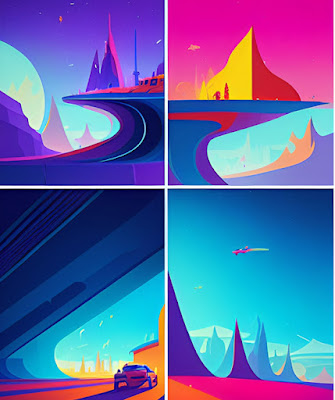Wednesday Writing Tip: The Four Block Method of Scene Writing
I worked out this "Four Block" method of writing a scene for my AI for Authors Fiction Writing Guide. Then I discovered, hey, you don't need to work with an AI for this method to be useful.
So I present it here as a writing tip on its own.
First, let's review what constitutes a scene. Bear with me if you know this already. It's a short review.
There are two kinds of scenes, and, confusingly one kind of scene is called Scene and the other kind of scene is called Summary. Think of them as Show and Tell. I know, you've heard it a million times to Show Not Tell. Mostly, that's right. The fact that Steve the AI tends to Tell rather than Show is one of the reasons purely Steve-generated stories sound more like a synopsis than a real story.
A Show scene is a detailed and immersive portrayal of a moment in the story that focuses on action, dialogue, and sensory details. Scenes usually involve characters interacting in a specific time and place and move the plot forward by revealing important information and advancing the story.
On the other hand, Summary/Tell is a condensed retelling of events that skips over the details and focuses on the most important information. Summaries are useful for skimming over the boring bits, and are often used to cover long periods of time or events that are not important enough to warrant a full scene.
Show Scenes are typically used for important moments in a story, such as key plot points or character development. They allow the reader to experience the moment in real-time, which can create a strong emotional connection to the story. Summaries, on the other hand, are more commonly used for exposition or to provide context for the events of the story. Summaries also act like glue to link Show Scenes together logically. If one Show Scene ends with the characters in a boat going down river, and the next Show Scene starts in a hotel, a bit of Summary is needed to explain how they got from the river to the hotel.
Another way of looking at these two kinds of scenes in a book is Action and Reflection. The Action scene unfolds like a blow-by-blow action shot in a movie. The Reflection is that part of the movie where there is a montage with moody music and a voiceover. One is a Doing Stuff scene and the other is a Thinking About It scene.
Now that we've reviewed the basics for the kids in the back row who slept through orientation, let's get back to how to build scenes. The techniques we want to use will depend on whether we are talking about an Action/Showing/Doing scene or a Reaction/Reflection/Telling summary.
* * *
Let's start with some action, as your book should.
We're going to build this action scene the way a toddler builds a tower, one block at a time. It takes between two and six blocks to make a scene. Let's aim to have four blocks in an average scene. Why four? Because an easy-to-write block of usable narrative is around 250 words, and you'll need four of those to make a 1000 word scene.
* * *
Block 1: Establish where the scene takes place, who's point of view it is, and who else is there. Bonus points if the scene starts with a hook.
Block 2: The PoV character attempts to achieve some goal, which is thwarted, often by other characters there, but sometimes by some other force, such as nature.
Block 3: The conflict escalates. Often, there's a twist, a surprise.
Block 4: The conflict resolves, but in such a way as to lead to a now problem. The scene should end on a cliffhanger.
* * *
In other words, a scene is a three or four act mini-story, a little drama in and of itself.
It's like a four-act play. Or, if you like, you can think of it as a three-act play, since Blocks 2 and 3 are similar. However, I like to keep them separate because the middle part of the scene should be twice as long as the intro and extro parts; here you can think of every block as the same length, but have two blocks for that core, meaty part of the scene.
The other reason I like to differentiate Block 3 is because if there's going to be a surprise or twist in the scene, this is where it will usually occur.
Of course, don't follow the blocks "woodenly." (Haha.) If you want to introduce the action first, then pull back to describe what's going on (essentially reversing the order of blocks 1 and 2) or if you don't have an especially strong "twist" for this scene, only an ongoing debate amongst the characters, that's okay.
Some scenes will also naturally be shorter, others longer. A "scene" in your book might be 3000 words instead of 1000. I usually start off The Unfinished Song novels with a strong and especially detailed 2000-3000 word scene for both my Heroine and my Hero, to firmly establish the reader in their PoV. Only then do I start throwing in shorter scenes, often from supporting characters' PoV.
That's also because just as you frontload a scene with description, you frontload a novel with description. By the end of a scene, as by the end of the novel, you don't want to drag the pace by describing things any more, you want tension and action.

Comments